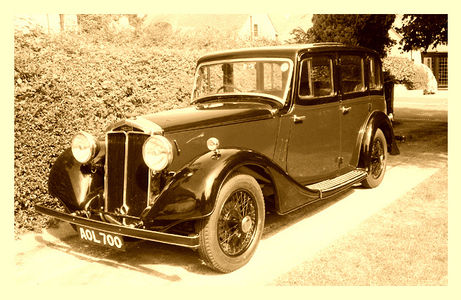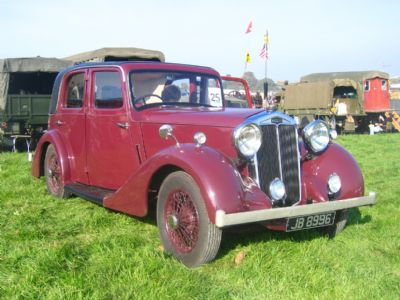Lanchester Eighteen 1934 - 1939
The Lanchester "New" Eighteen was introduced as a replacement for Lanchester's existing 18hp model and was well-received by the motoring press.
Chassis designation:
E18
Number produced (maximum):
901
Chassis allocations:
12291- 12649 = 359
12650 - 12841= 192
13275 - 13624 = 350
Total = 901
USEFUL DATA:
1934/5 Lanchester "Eighteen" (17.97h.p.)
Engine (monobloc):
Number of cylinders: 6-in-line
Capacity (c.c.): 2,390 (69.5mm bore x 105mm stroke)
R.A.C. rating: 17.97
Compression ratio: 6:1
Valve clearance: Inlet: 50 thou; Exhaust 54 thou.
Firing order: 1, 5, 3, 6, 2, 4
Sparking plugs: NGK BP6ES (modern equivalent)
Transmission
1934/5 Lanchester "Eighteen" (17.97h.p.)
Pre-selective Wilson gearbox mated to Daimler fluid flywheel
Gear ratios:
1st: 19.82:1
2nd: 11.27:1
3rd: 7.58:1
Top: 4.86:1
Reverse: 31.57:1
Rear axle ratio: 4.86:1
M.P.H. on top gear: 68
Capacities
1934/5 Lanchester "Eighteen" (17.97h.p.)
Fuel tank: 18 gallons
Reserve supply: 2 gallons
Dimensions:
Tyre size: 5.50 x 18
Wheelbase: 9ft 3ins
Track: 4ft 8ins
Length overall: 14ft 11 1/2ins
Ground clearance: 6ins
Weight (car complete): 29 3/4cwt
Lubricants:
Engine: Straight 30 grade
Gearbox: Straight 30 grade
Fluid flywheel: Straight 30 grade
Rear axle: Straight 140 grade
21st September 1934
The Autocar
"Three Special New Cars"
19th April 1935
The Autocar
"18h.p. Lanchester Saloon"
7th January 1936
The Motor
"The Lanchester Eighteen Saloon"
19th January 1937
The Motor
"The Lanchester "Eighteen" Six Light Saloon"
30th April 1937
The Autocar
"Lanchester Eighteen Saloon"
February 1938
Motor Sport
"The 18h.p. Lanchester Saloon"
USEFUL DATA:
1935/6 Lanchester "Eighteen" (19.3h.p.)
Engine (monobloc):
Number of cylinders: 6-in-line
Capacity (c.c.): 2,565 (72mm bore x 105mm stroke)
R.A.C. rating: 19.3
Compression ratio: 6:1
Valve clearance: Inlet: 52 thou; Exhaust 54 thou.
Firing order: 1, 5, 3, 6, 2, 4
Sparking plugs: NGK BP6ES (modern equivalent)
1937/8 Lanchester "Eighteen" (19.3h.p.)
As 1935/6 with the following exceptions:
CAPACITIES
Engine oil: 17 pints (Straight 30)
F/Flywheel: 8 1/2 pints (Straight 30)
Rear axle: 2 1/2 pints (Straight 140)
Cooling system: 17 pints
Fuel tank (inc.reserve of 2 gallons): 20 gallons
DIMENSIONS
Wheelbase: 9ft 6ins
Length overall: 15ft 3ins
Ground clearance: 7ins
Weight of Standard Saloon:
31 1/2cwts
Transmission
1935/6 Lanchester "Eighteen" (19.3h.p.)
Pre-selective Wilson gearbox mated to Daimler fluid flywheel
Gear ratios:
1st: 4.08
2nd: 2.32
3rd: 1.56
Top: Direct
Reverse: 5.4
Rear axle ratio: 4.86
R.P.M. of engine in Top @ 60 M.P.H.: 3,380
Capacities
1935/6 Lanchester "Eighteen" (19.3h.p.)
Fuel tank: 18 gallons
Reserve supply: 2 gallons
Dimensions:Turning circle: 38ft
Tyre size: 5.50 x 18
Wheelbase: 9ft 3ins
Track: 4ft 8ins
Length overall: 14ft 11 1/2ins
Ground clearance: 6ins
Weight (chassis only): 21 1/2cwts
Lubricants:
Engine: 15 pints (Straight 30 grade)
Gearbox: 5 pints (Straight 30 grade)
F/Flywheel: 9 pints (Straight 30 grade)
Rear axle: 3 pints (Straight 140 grade)
Cooling system: 18 pints
Road Test dates
History. Dave Philpot
The Lanchester "New" Eighteen ( chassis designation E18), was introduced to the world at the Olympia Show in the autumn of 1934.
This was a "New" model in the genuine sense of the word, as it shared little with the previous Lanchester "18" model, which could trace its origins back as far as 1932 when launched as the Lanchester 15/18.
Whereas the previous "18" model's engine was of 2,504c.c., the E18's 'monobloc' engine was of a smaller capacity at 2,390c.c., though with an almost identical power output to the earlier, larger engine, being rated at 17.97 RAC H.P. Oil consumption for the 2,390c.c. unit was quoted at between 1,500 and 2,000 miles per gallon - very respectable figures for the time!
The Lanchester "New" Eighteen was a definite 'hit' with the motoring press, with contemporary reports noting built quality, silent running, ride quality and handling characteristics in particular.

As was the 'norm' at the time, various coachbuilders were to offer their particular wares on the Lanchester E18 chassis, with saloons more often appearing with coachwork either from Mulliners (Birmingham) Ltd., or from the Radford works bearing the name of either the Lanchester or Daimler companies (one such saloon of note bearing Lanchester aluminium coachwork being supplied in early 1936 to the Duke of York, who would later become H.M. King George VI. This car still survives).
In July 1935, a new model of Daimler launched, the Daimler "Light Twenty"(E20). Although of similar design to the Lanchester Eighteen, the engine was of 2,565c.c (19.3 RAC H.P.) and the wheelbase was at 9' 6", three inches greater than that of the Lanchester.
The Lanchester too, was to run this new power unit, though evidence exists that new cars with the smaller engine were still being registered in late 1935. Certainly, by December 1935, cars were advertised as having the larger engine of the two. The model retained the "Eighteen" name, despite the increase in horsepower.

Photo: Ron Fisher
The next major changes to the Eighteen came about with the wheelbase being increased to match that of the Daimler "Light Twenty" - 9' 6", and the car gaining an updated frontal appearance, where the bonnet was now a centre-hinged affair - as opposed to the original three-piece arrangement - and the radiator shell being redesigned and of smaller dimensions than the preceding type fitted. These frontal changes are described in a contemporary report by the "Motor" magazine dated 19/1/1937 as the appearance having been modified for 1937.
As with the Daimler "Twenty" - as the "Light Twenty" had become known, the prices of the Lanchester Eighteen (E18) dropped towards the end of production. To illustrate: On introduction, the "Autocar" magazine (dated 21/9/1934) quoted the cost of a standard 6-light saloon (model 316) as £580. By September 1938, Co. material gives the price of a comparable saloon (model 481) as £525 - a drop in price of nearly ten percent!!
The Lanchester Eighteen ceased to be available in 1939, and post-war - with the exception of two special order Lanchester 27hp cars, and two Lanchester Dauphins, no model of Lanchester greater than 14hp was offered.
To 2019 - the time of writing - and the Lanchester "New" Eighteen(E18) has survived in far fewer numbers than the comparable Daimler (E20) offering, with perhaps only a dozen-and-a-half roadworthy examples extant worldwide, making it a rare car indeed!

Coachbuilders:
The following coachbuilders are known to have built at least one body on the "E18" chassis. Again, this list is by no means exhaustive:
Charlesworth Bodies (1931) Ltd.
Corsica
Daimler Co. Ltd.
Lanchester
Martin Walter Ltd.
Mayfair Carriage Co. Ltd.
Mulliners (Birmingham) Ltd.
Ranalah Coachworks Ltd.
Salmons & Sons
Vanden Plas Ltd.
The accompanying photographs and illustrations show various styles of coachwork offered by some of the above. It should be noted that at the time of writing, the identification of several of the coachbuilders remains unclear/unknown, and in certain cases the Club records contain conflicting information, where a (?) can be seen by the name of the coachbuilder.
Maintenance Manuals & Spare Parts Catalogues
The accompanying cover scans illustrate the following:
Lanchester "18" Maintenance Manual dated 25-1-35 (2,390c.c.)
Earlier (19.3hp) Lanchester "18" Maintenance Manual dated 12-12-35 (2,565c.c.)
Later (19.3hp) Lanchester "18" Maintenance Manual reprinted 5-45 (2,565c.c.)
T.C.97 Spare Parts Book (12,291 - 12649; 2,390c.c.)
T.C.105 Spare Parts Book (12,650 - 12,841; 2,565c.c.)
T.C.113 Spare Parts Book (13,275 - 13,624; 2,565c.c.)

Wiring Diagram
E18 (Early) Wiring Diagram


































